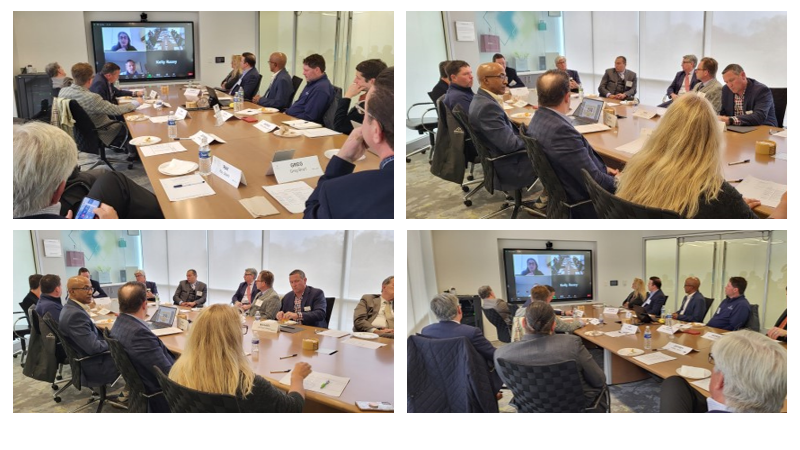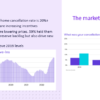Pittsburgh October 2022 – Key Take-Aways
Veronica Minello, CoStar Group, guest speaker, senior market analyst responsible for market reports, news articles, and client presentations. Provided an overview of the Pittsburgh industrial and multifamily markets, with a national overview for context and then Pittsburgh area data.
On the national outlook for Industrial: We’re running about $18 billion above where we would be if spending had grown along the pre-Covid trend. Even though we’re down from a peak early last year, we’re strong in retail tied to leasing. Supply and demand: We have around 100 million square feet of space absorbed, still well above last year. Supply has outpaced demand since mid-2020.
Leasing activity is about 60 percent above pre-pandemic levels. Record-setting level of imports.
Construction: We have about 900 million square feet of space under way and 70 percent unleased. Even if all unleased space delivered in the next year, it remains manageable and fairly low by historical standards.
Data for Pittsburgh: We’re still seeing vacancies inch lower. Demand is not surging as we saw on a national level, but it’s still strong relative to recent quarters. Lots of movement related to deliveries; retailers seeking out new and modern distribution space. Annual net absorption as a percent of inventory: Pittsburgh fares well, in line with Cleveland and Detroit.
Vacancies in the third quarter: Most markets have had depression in vacancies, but we are around where we were at the start of 2020.
National multifamily market:
Demand has slowed from a blistering 2021 pace. We’re at about one-third of last year’s total over the same time period, but deliveries are not slowing down so that pushed vacancies up.
We have about 900,000 units under way as of the third quarter. A large number of properties were permitted but developers were awaiting supplies. Now we have high interest rates that can make it difficult to get financing.
Pittsburgh data:
Apartment demand is moderating – 18 percent of the annual average in the three years leading up to the pandemic. Deliveries are limited, vacancies are below the 10-year average at around 4.8 percent as of the third quarter. Downtown represents the lion’s share of demand in the past year; Butler County is also active, with about 16 percent of annual absorption.
Comparing demand to percent of inventory, the Pittsburgh market ranks among the lowest in line with Minneapolis and Cleveland. Those that are growing are Columbus and Milwaukee.
Chip Desmone, Desmone Architects: The CoStar report mirrors what I’m seeing. I see about 2,000 more units in Downtown and the Strip coming up over the course of next year; industrial stuff is going gangbusters, about 1.5 million square feet of industrial and tech flex coming on market in the next year and a half. We’re still pretty active. For our company, the backlog is still really strong. I haven’t seen any interest rate effects yet, in terms of clients putting anything on hold; I guess there may be a recession coming but no one’s telling me to stop work yet.
Patrick Cersosimo, Apartner Multifamily Capital: We’re multifamily investment specialists. We look at hundreds of properties in a year. We’re seeing similar market corrections and reactions. We only acquire Class B properties. Anytime we see the type of surges we’ve seen in the past few years; it causes a shock to rates. Rent growth surged but hopefully it’s getting back to normal. We prefer Class B because we’re looking for working-class individuals; it’s the largest renter pool. We buy and operate for about seven years and then turn around.
Wes Easly, Ice Breaker Resources: I travel coast to coast about 90 percent of my time. The attitude toward Pittsburgh is, this has got to be a recession-proof market in their mind. You guys don’t suffer the lows the way everyone else does, but when they dig below the surface there’s a sheer lack of data to make underwriting work. Data is too low a sample size for big investors; they get gun-shy quickly. So, the same groups do multiple deals, as opposed to a new infusion. That will change when there’s secondary sales of these new builds. With the whole ESG movement, big global corporations have pushed billions of dollars. Creative real estate investment groups have found carve outs, such as affordable housing.
Greg Boyd, NexTier Bank: Interest rates continue to make things tough. Transactions are closing but getting harder and fewer in between. We’ve had a couple situations put on hold. It’s sad when the Treasury increases the interest rates to slow things down and they’re literally slowing things down. Projects won’t get done.
Kevin Melquist, Cobblestone Inspections Group: We’ve inspected 300-plus units before April but since then only about 200, between here and Erie. As soon as they started raising interest rates, it dropped. I’m inspecting a lot of small office space; there’s an uptick in that, as opposed to large multifamily purchases.






Recent Comments